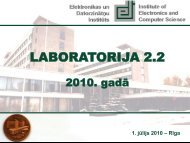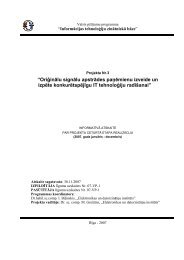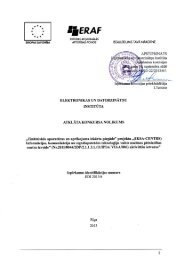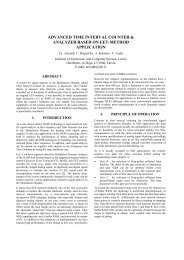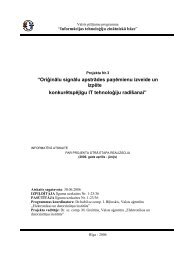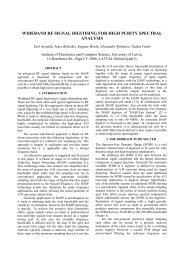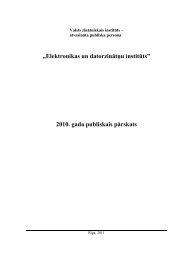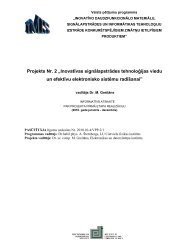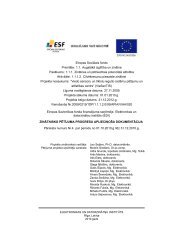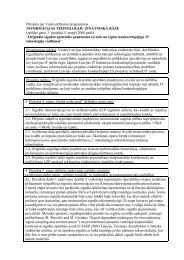A032-ET - International Laser Ranging Service
A032-ET - International Laser Ranging Service
A032-ET - International Laser Ranging Service
You also want an ePaper? Increase the reach of your titles
YUMPU automatically turns print PDFs into web optimized ePapers that Google loves.
Event Timer <strong>A032</strong>-<strong>ET</strong>ManualInstitute of Electronics and Computer ScienceRiga, Latvia
Event Timer <strong>A032</strong>-<strong>ET</strong>NOTICESSAF<strong>ET</strong>YWarning. Dangerous voltages, capable of causing death, are present in the <strong>A032</strong>-<strong>ET</strong>hardware. Use extreme caution whenever the device cover is removed.Line voltage. The <strong>A032</strong>-<strong>ET</strong> hardware operates from 100 to 240 V nominal ac powersource. Verify that your power source complies this condition.Power cord. The <strong>A032</strong>-<strong>ET</strong> is supplied with the detachable, three-wire power cord forconnection to the power source and to a protective ground. Always use an outlet, whichhas a properly connected protective ground.PREPARATION FOR USEWarning. The <strong>A032</strong>-<strong>ET</strong> needs careful handling and should be served by skilledspecialists. Especially be careful to the <strong>A032</strong>-<strong>ET</strong> hardware interconnection sinceincorrect handling can damage the device.Necessarily read this Manual over before any initial actions with the instrument. Feel freeto ask (E-mail: artyukh@edi.lv) if you will have any troubles concerning the <strong>A032</strong>-<strong>ET</strong>application.The <strong>A032</strong>-<strong>ET</strong> hardware contains a complicated finely adjusted electronic circuit. Do notremove the device cover without special necessity to protect this circuit from anycareless handling.Hardware connection to PC. The <strong>A032</strong>-<strong>ET</strong> is supplied with the detachable connectingcable for hardware connection to the PC parallel port. Always use this cable to ensurethe <strong>A032</strong>-<strong>ET</strong> reliable operation.Hardware connection to other instruments. Carefully read part 3.2 of this Manual todefine in details all requirements to the signals that you will use in your application. Theinstrument may lose the specified precision or even be damaged if operated withunforeseen signals.WARRANTYThe <strong>A032</strong>-<strong>ET</strong> hardware is warranted to be free from any hidden defects in material andworkmanship for one year from the date of purchase. During this warranty period theManufacturer repairs the device at no charge or replaces it with a new one. TheManufacturer does not assume responsibility for any damages of the instrument causedby incorrect user handling.2
Event Timer <strong>A032</strong>-<strong>ET</strong>CONTENTSNotices ………………………………………………………………………. 21. Overview ………………………………………………………………… 42. Main features of the Event Timer ……………………………………. 62.1. Architecture ……………………………………………………….. 62.2. Principles of operation ………………………………………….. 62.3. Typical precision characteristics ……………..………………. 92.4. Controlling the Event Timer ……………………………………. 102.4.1. Control procedures for the <strong>A032</strong>.1 option …….. 102.4.2. Control procedures for the <strong>A032</strong>.2 option …….. 123. Preparing the Event Timer for operation ………………………..…. 133.1. Structure …………………………………………………………… 133.2. <strong>ET</strong>-device ………………………………………………….…….… 143.3. Requirement to PC supporting the <strong>ET</strong>-sever ………... ……... 153.4. Software installation ……………………………………………... 15ANNEX A. Server-Client interaction procedures ..……………………17ANNEX B. DEMO subsystem <strong>A032</strong>.1-C1 …………..……………………26ANNEX C. DEMO subsystem <strong>A032</strong>.2-C2 ………………………………..313
Event Timer <strong>A032</strong>-<strong>ET</strong>1. OverviewThe Event Timer <strong>A032</strong>-<strong>ET</strong> is a computer-based instrument that precisely measures the timeswhen events (input pulse comings) occur. The <strong>A032</strong>-<strong>ET</strong> can be used for various applicationswhere picosecond-precision wide-range and high-speed timing measurements are especiallyneeded. First and foremost the <strong>A032</strong>-<strong>ET</strong> is designed for applications related to Satellite <strong>Laser</strong><strong>Ranging</strong>, although it can be also well suitable for other applications (such as time-of-flightspectrometry).There are two currently available options of the <strong>A032</strong>-<strong>ET</strong>, which use the same specializedhardware but differ by the software. These options provide alternatively two basic kinds ofmeasurement:The option <strong>A032</strong>.1 provides continuous (gapless) measurement of events at high (up to10 KHz) mean measurement rate, allowing bursts of the rate up to 16 MHz. This option iswell suitable to measure the overlapped time intervals between Start and Stop events thatcome at the separate inputs (either A or B) of the Event Timer in any order. Specifically thisis the case of advanced Satellite <strong>Laser</strong> <strong>Ranging</strong> at KHz repetition rate. In such applicationsthe Event Timer is well competitive as compared with the highest-performance event timerscurrently available.The option <strong>A032</strong>.2 provides cyclical measurement of events that come at the separateinputs of the <strong>ET</strong>-device in the strict order: in every cycle at first the Event Timer measures asingle Start event coming at the input A, and then - a user-defined number of Stop events (upto 12,000) coming at the input B. The Stop events are measured within internal onlineprogrammable gate. Specifically this is the case of conventional Satellite <strong>Laser</strong> <strong>Ranging</strong>where the measured Start-Stop time intervals do not exceed the repetition period of Startevents. In such applications the <strong>A032</strong>.2 considerably surpasses possibilities of the traditionaltime interval counters in both precision and functionality.The <strong>A032</strong>-<strong>ET</strong> interacts with user’s application programs via the network, providing overallremote control and remote applications in multi-user mode. Owing to employing a novelmeasurement method, the <strong>A032</strong>-<strong>ET</strong> offers high performance characteristics, using compact andrelatively inexpensive specialized hardware. As a result the <strong>A032</strong>-<strong>ET</strong> combined with user-madeor custom-made application program can be used to create various top-quality and reasonablypriced timing systems.<strong>A032</strong>-<strong>ET</strong> main features:- Two inputs A and B for the events being measured- Time-tag marking specifying the input (either A or B) that provides the measured event- Output data presentation as time-tags synchronized to real-time clock- FIFO depth up to 12,000 time-tags- Two software options supporting different order of event incoming- 16 MHz maximum measurement rate- Up to 10 KHz mean rate of continuous (gapless) measurement (the <strong>A032</strong>.1 option)- Up to 500 Hz cycle repetition rate (the <strong>A032</strong>.2 option)- Internal online programmable gating with 10 ns LSD (the <strong>A032</strong>.2 option)- Remote control and timing data transfer via the TCP/IP network- Self-calibration and precision testing4
Event Timer <strong>A032</strong>-<strong>ET</strong>Summary of specificationsInputs (BNC):Output (BNC):INPUT AINPUT BGATE INSYNC INTRIG INREF INTEST OUTSingle-shot RMS resolution **Dead timeNon-linearity errorOffset temperature stabilityWarm-up timeFIFO depthMeasurement rate ***<strong>A032</strong>.1 option<strong>A032</strong>.2 optionTriggeringTime-baseStop pulse gating<strong>A032</strong>.1 option<strong>A032</strong>.2 optionControlApplication interfaceHardware interfaceSoftwareAccessory softwareHardware dimension, weightPower supplyNIM pulse (falling edge; >5 ns width) *NIM pulse (falling edge; >5 ns width) *NIM pulse (high level)TTL pulse (rising edge, 1 pps)TTL pulse (rising edge)10 MHz (>0.5 V p-p)NIM pulse indicating the gate delay (the <strong>A032</strong>.2 option)
Event Timer <strong>A032</strong>-<strong>ET</strong>2. Main features of the Event Timer2.1. ArchitectureLike most of the virtual instruments, the <strong>A032</strong>-<strong>ET</strong> performs its measurement functions partly byhardware means and partly by software means. The measurement software provides interfacingwith a user program via TCP/IP network on the basis of well-known “Client/Server” scheme(Fig.1). The user program can control the <strong>A032</strong>-<strong>ET</strong> via this interface and receive measurementdata from for further specific-application processing. This is not quite the usual way ascompared to another ways of connecting devices to user’s PC (such as parallel ports, serialports and USB). However the network connection offers capacities that are inaccessible for themost of conventional connections, especially in the case of designing distributed timingsystems. At the same time the network interface based on TCP/IP standards is quite get-at-ablefor users as almost all Software Development Kits contain the library with the required TCPfunctions.In terms of the Client/Server architecture the<strong>A032</strong>-<strong>ET</strong> can be considered as combination ofa specialised timing device (subsequentlyreferred to as <strong>ET</strong>-device), and a specialisedServer (subsequently referred to as <strong>ET</strong>-server)dedicated both to managing the <strong>ET</strong>-device andprocessing the timing data obtained from it(Fig.1). In this case the <strong>ET</strong>-client is a PC onwhich user runs his application, using thespecific <strong>ET</strong>-server resources via network. Notethat in many cases a single PC under MS-Windows can serve as both the <strong>ET</strong>-server andthe <strong>ET</strong>-client although use of a separate PC forthe <strong>ET</strong>-server is preferable to achieve thehighest operating speed.<strong>ET</strong>-deviceMeasurementsoftwareNetwork connectionFig.1. Network architecture of the Event TimerThe <strong>ET</strong>-device is compatible with different options of the <strong>ET</strong>-server software, providing differentmodes of the timer operation. Currently two kinds of <strong>ET</strong>-server software are available,specifying the option (either <strong>A032</strong>.1 or <strong>A032</strong>.2) of the Event Timer <strong>A032</strong>-<strong>ET</strong> as a whole. Any ofthese options can be used alternatively depending on the current user task.Event Timer <strong>A032</strong>-<strong>ET</strong><strong>ET</strong>-serverInputsTCP/IPPCInteraction via EPPTCP/IPPCUser program<strong>ET</strong>-client2.2. Principles of operationThe <strong>A032</strong>-<strong>ET</strong> performs the measurement of input events in two stages. At first, the <strong>ET</strong>-devicetransforms every input event into single 80-bit timing data block (subsequently referred to asTD-block) and sequentially accumulates such TD-blocks in a buffer FIFO memory. Each TDblockcontains the rough data (39 bits) and interpolating data (40 bits) about the time of eventincoming, as well as one-bit mark specifying the input (either A or B) providing the measuredevent. Note that the interpolating data are presented initially in an intermediate redundant formand needs further an additional processing by the <strong>ET</strong>-server.The used unconventional method of time interpolation supports both high precision and highspeed. Specifically, using 100 MHz internal clocks it provides each single measurement with
Event Timer <strong>A032</strong>-<strong>ET</strong>At the next stage the <strong>ET</strong>-server takes out TD-blocks from the FIFO memory and processesthem to obtain the corresponding time-tags in a unified form. Further these time-tags are sent tothe <strong>ET</strong>-client via network. To achieve the best precision, processing of TD-block takes intoaccount the actual physical characteristics of time interpolation under actual operatingconditions of the <strong>ET</strong>-device; these characteristics are defined through so called scaling(calibration) procedure before the measurement.The <strong>ET</strong>-device is flexibly controllable and, in particular, allows writing TD-blocks in the FIFOmemory and reading of them by the <strong>ET</strong>-server in different modes depending on the event timeroption:The <strong>A032</strong>.1 option provides continuous (gapless) event measurement during practicallyunlimited time. To do that, the <strong>ET</strong>-device continuously accumulates TD-blocks in FIFOmemory in order of measured event incoming. Concurrently with this process, the <strong>ET</strong>servercontinuously monitors the current state of the FIFO memory with some userdefinedperiod T M to detect the state when the amount M of TD-blocks exceeds the userselectablevalue (204, 102, 50, or 25 TD-blocks). The rest of the FIFO memory capacity isused to damp possible bursts of input event intensity.When the specified FIFO state is detected, the <strong>ET</strong>-server takes out M TD-blocks from the<strong>ET</strong>-device, processes them and sends the corresponding time-tags to the <strong>ET</strong>-client(Fig.2). Such procedure is being cyclically repeated. In this way continuous eventregistration goes together with cyclical timing data processing and sending the time-tagsto the <strong>ET</strong>-client via TCP interface.TD-blocksMFIFO fillingFIFOmonitoringDatareadingT MDataprocessingand sendingTo TCPTo TCPTo TCPTo TCPTo TCPFig.2. Schematic time diagram, illustrating process of data reading from the <strong>ET</strong>-deviceThe maximum available mean rate of such continuous measurement is limited mainly bythe available reading and processing speed of the TD-block by PC of the <strong>ET</strong>-server.Typically (although it may depend on the actual performance of the PC) the total time ofreading and processing of the single TD-block is about 0.1 ms, resulting in maximummean measurement rate about 10 KHz.In any specific application the monitoring period T M and the amount M of TD-blocks canbe adapted to the expected mean rate R of event measurement to avoid FIFO memoryoverflow. Generally the period T M has to be defined so that it is a little less than the meantime M/R of accumulating M TD-blocks in the FIFO memory in view of the rate R. Forexample, if R=10 KHz and M=204, the period T M should be less than the timeM/R=20.4 ms. The minimum allowable value of T M is 10 ms.Note that the values M=204 and T M =15-20 ms are applicable for any rate R
Event Timer <strong>A032</strong>-<strong>ET</strong>resulting in too large delay of receiving the first time-tags by the <strong>ET</strong>-client. In some casesthis may cause unwanted problems with real-time operation of the <strong>ET</strong>-client. In suchcases it is recommended to decrease the M value as far as possible. For example, ifR=0.5 KHz and M=25, the time M/R=50 ms and period T M may be about 45 ms.The <strong>A032</strong>.2 option provides cyclical measurement of events that come at the separate inputsof the <strong>ET</strong>-device in a strict order. Specifically, in the beginning of each cycle the EventTimer measures a single Start-event coming at the Input A of the <strong>ET</strong>-device, and onlythen - a number of Stop-events (up to 12,000) coming at the Input B (Fig.3). The Stopeventsare registered over internal gate. The gate delay T Dj is programmable by the <strong>ET</strong>clientin a wide range with 10 ns LSD resolution.T CINPUT ARegistered Start eventsINPUT BT DjRegistered Stop eventsT D(j+1)GatingDatareadingDataprocessingand sendingT WT RTo TCPTo TCPFig.3. Time diagram illustrating the measurement provided by the A031.2 optionUnlike the <strong>A032</strong>.1 option, in this case the <strong>ET</strong>-device at first accumulates TD-blocks in theFIFO memory during some user-defined waiting period T W , starting from Start-eventregistration. During this time the <strong>ET</strong>-server processes TD-blocks read out from the <strong>ET</strong>devicein previous cycle, and sends the corresponding time-tags to the <strong>ET</strong>-client. Then the<strong>ET</strong>-server interrupts the event registration, reads the currently accumulated TD-blocksand allows starting the next similar cycle. In any case the amount of TD-blocks read bythe <strong>ET</strong>-server does not exceed the user-defined value M (from 1 to 12,000). The waitingperiod T W can be defined in a wide range with a 1 ms step.During the waiting period T W the <strong>ET</strong>-server can receive a command from the <strong>ET</strong>-client torestart the measurement with modified gate delay. In this case the next measurementcycle will be performed with a new gate delay. For example, the restart commandcontaining a modified gating parameter can be cyclically sent by the <strong>ET</strong>-client in responseto each received batch of timing data. In this way online cycle-to-cycle controllable gatingis possible. However it should be taken into account that the TCP/IP network may producesome unexpected delays for real-time data exchange, resulting in episodic loss ofsynchronism in such interactive operation at high (more than tens of Hz) repetition rate ofmeasurement cycles.The minimum available cycle duration T C is defined by time period of data processing (thatshould be less than the waiting period T W ) and time period T R of data reading. Total timeof these operations depends on the amount of TD-blocks that the <strong>ET</strong>-server reads andprocesses. The time additionally needed for network interactions depends on the networkperformance and its actual load. These things should be taken into account to choose theparameters T W and M so that they are well matched with the specific measurementconditions.8
Event Timer <strong>A032</strong>-<strong>ET</strong>Generally the <strong>A032</strong>.2 option is oriented mainly to applications with cycle repetition rate upto tens of Hz (this is the case of conventional Satellite <strong>Laser</strong> <strong>Ranging</strong>). But if the M valueis not too large (
Event Timer <strong>A032</strong>-<strong>ET</strong>error surely does not exceed 1 ps at least for time intervals greater than 100 ns (Fig.6). For themeasurement of smaller (less than 100 ns) time intervals, the damping transient of timerrecovery may produce some noticeable non-linearity error in this range. But even in this casethe non-linearity error typically does not exceed 3-5 ps.2.3.3. Offset driftThere is some additive, internally produced offset in time interval measurement if the Starteventand Stop-event are provided by the different inputs (A and B) of the <strong>ET</strong>-device. This offsetis caused by a difference between propagation delays of input signals to the single input ofcommon measurement block. Generally these delays are temperature dependent and a slightdrift of offset under time-varying operating conditions is possible.As can be seen in Fig.8, theoffset has noticeable drifts(about 2 ps) only directly after<strong>ET</strong>-device power-up whentemperature inside the caserose from 20 to 40 0 C approx.Thus, it may be roughlyconcluded that the temperaturecoefficient of the offset variationdoes not exceed 0.1 ps/ 0 C.For time interval measurementsthrough any single input of the<strong>ET</strong>-device, the offset drift is0 1 hr 2 hr 3 hr 4 hrcaused by the absolute drift of Fig.8. Offset drift during 4.2 hr after hardware power-upthe corresponding propagationdelay during measured time interval and may be noticeable only for large (a few seconds andmore) time intervals.2.3.4. Time-base errorThe actual value of reference frequency and its stability directly affect the measurement error.Basically the <strong>A032</strong>-<strong>ET</strong> is oriented to using external high-performance sources of referencefrequency (such as GPS Time and Frequency Standards) and only for this case the specifiedprecision is guaranteed. Although self-contained operation using own clock source (+/-10 ppm)is available.2.4. Controlling the Event TimerThe <strong>A032</strong>-<strong>ET</strong> operation is fully controlled by the <strong>ET</strong>-client via TCP/IP network. For this reason itis very important to understand exactly all protocol procedures concerning such control.As the <strong>A032</strong>-<strong>ET</strong> is a multi-user resource, an <strong>ET</strong>-client should establish a Session with the <strong>ET</strong>serverbefore any other interactions. In this way, the <strong>ET</strong>-client captures the <strong>A032</strong>-<strong>ET</strong> forexclusive use, up to the Session break.The control procedures available during the Session are clarified below descriptively. Moreexactly these procedures are described in ANNEX A. To learn more details of implementing theprotocol procedures in a user program you may additionally examine the DEMO software (seeANNEX B and ANNEX C).There are four preparatory procedures:- Scaling (calibration)10
Event Timer <strong>A032</strong>-<strong>ET</strong>- Time synchronization- Time monitoring- Settingand one basic procedure:- Measurement.In many respects the above procedures are similar for both options but some differ in essentialdetails. So they are described below separately for each option.2.4.1. Control procedures for the <strong>A032</strong>.1 optionScaling. This procedure provides adaptation of the Event Timer to the actual operatingconditions to achieve the best available measurement precision. The procedure includesstatistical identification of the <strong>ET</strong>-device physical characteristics under current operatingconditions (mainly – under temperature conditions), modification of the processingparameters in view of the identified characteristics, and self-estimation of actualmeasurement precision offered after the scaling has been performed. The self-estimationis based on measurement of an internal test signal and uses a special approach toexclude the influence of test signal jitter on the estimation result.Additionally the procedure includes checking of presence of the external 10 MHzreference signal. It is supposed that such signal is provided basically by a high-stablesource (such as GPS frequency standard). If the reference signal is not found, the <strong>ET</strong>devicestill is able for operating, using automatically connected internal clock source( 100 MHz/10 ppm VCXO).After completing the scaling procedure the <strong>ET</strong>-sever sends to the <strong>ET</strong>-client an estimate ofactual precision that is offered for the following measurement, and info concerning theexternal 10 MHz reference signal. Typically the estimate of actual precision (RMSresolution) should be surely better than 10 ps.Normally the scaling procedure lasts about 10 seconds. It may be repeated by the <strong>ET</strong>clientat any instant, for example, with the aim to check once more the offered precision ofmeasurement or refresh the previous scaling result if the operating conditions were varied.Time synchronization. This procedure, as well as the next procedure of timemonitoring, can be performed only if the <strong>ET</strong>-device receives 1 pps sync pulses from anexternal source (such as Time and Frequency GPS standard). If this condition cannot besupported, both of the mentioned procedures can be omitted. In this case the Event Timerwill be able for further operating but output time-tags will not be synchronized to the realtimeclock.The procedure provides synchronization of the timer’s clock with both real-time clock ofthe server PC and 1 pps sync pulses. Synchronization is possible if during 10 sec at least4 sequential sync pulses are stable so that deviation of time intervals between thesepulses from 1 s does not exceed 100 ns. This is an ordinary requirement for the most ofhigh-performance Time and Frequency standards.When the procedure is completed, the <strong>ET</strong>-server sends to the <strong>ET</strong>-client the dataconcerning the time of synchronization. Besides, this data simply indicates that theprocedure was completed successfully.Note that successful time synchronization may become incorrect if during 1.5 hours afterperforming it the Event Timer has not been used either for the measurement or timemonitoring (see below). To avoid this case it is recommended to activate the timemonitoring during long pauses between measurements or repeat the procedure directlybefore the next measurement.11
Event Timer <strong>A032</strong>-<strong>ET</strong>Time monitoring. Using this procedure, the <strong>ET</strong>-client can receive a sequence of timetagscorresponding to incoming the 1 pps sync pulses. In other words, the <strong>ET</strong>-client cansee the real time provided by the timer’s clock to use that for various purposes, forexample, to check correctness of the time synchronization by comparing the timer’s clockwith any other available real-time clock. In the case of successful previous timesynchronization all time-tags should be multiple to 1 sec approx.The <strong>ET</strong>-client can end this procedure at any instant by sending the command STOP to the<strong>ET</strong>-server.Setting. Using this procedure the <strong>ET</strong>-client defines the main parameters of themeasurements. There are 4 separate parameters to be set:1. Time correction (user-definable positive or negative integer of seconds). As comparedto the time-tags provided after the time synchronization, further this value will beadded to the every time-tag before sending of it to the <strong>ET</strong>-client. This allows correctingthe time provided by the timer’s clock.2. Triggering (either external or internal). In the case of external triggering the start of ameasurement will be additionally synchronized by an external pulse at the input TRIGIN of the <strong>ET</strong>-device; in the case of internal triggering the measurement will be enableddirectly by the <strong>ET</strong>-client, without additional synchronization.3. Amount M of TD-blocks (user-selectable: 204, 102, 50 or 25). This is the amount ofTD-blocks, which the <strong>ET</strong>-server cyclically takes out from the <strong>ET</strong>-device, processes andsends to the <strong>ET</strong>-client.4. Monitoring period T M (user-definable from 10 ms with 1 ms step). This is a time perioddefining how often the <strong>ET</strong>-server checks the <strong>ET</strong>-device to detect the defined amountof TD- blocks in the FIFO memory.Measurement. Using this procedure the <strong>ET</strong>-client starts the measurement withparameters set before. During the measurement the <strong>ET</strong>-server cyclically sends the batchof M time-tags to the <strong>ET</strong>-client. Each time-tag is presented by two integers: data0 anddata1, specifying the time instant in the range 24 hours with 1 ps LSD resolution. Sign ofthe data0 defines the input of the <strong>ET</strong>-device providing the event. To calculate the eventtime from {data0, data1} the following simple expression is used:time[i] = (data0)x327680 + (data1)/1000 [ns]where possible negative sign of the data0 is set aside. Note that the size of batch receivedby the <strong>ET</strong>-client can differ from the size of batch sent by the <strong>ET</strong>-sever. Generally theTCP/IP protocol affords both splitting and merging the batch of data blocks to send it bythe sequential packets depending on the actual network performance and load. Thisshould be taken into account for the specific data processing by the <strong>ET</strong>-client.There is one more parameter user-defined at the starting (or restarting) of measurement.This parameter is transferred to the <strong>ET</strong>-server directly with the command START anddefines the period of a NIM pulse sequence generated at the TEST OUT output of the <strong>ET</strong>device.This additional feature is beyond the standard application of the <strong>A032</strong>.1 timeroption and can be used optionally.The <strong>ET</strong>-client can end the measurement procedure at any moment by sending thecommand STOP to the <strong>ET</strong>-server.2.4.2. Control procedures for the <strong>A032</strong>.2 optionThe above three procedures “Scaling”, “Time synchronization” and “Time monitoring” arefully identical for both of the options of <strong>ET</strong>-server. However the procedures “Setting” and12
Event Timer <strong>A032</strong>-<strong>ET</strong>“Measurement” for the <strong>A032</strong>.2 option differ in some essential details; they are describedbelow.Setting. As well as for the <strong>A032</strong>.1 option, there are 4 parameters to be set:1. Time correction (user-definable positive or negative integer of seconds). As comparedto the time-tags provided after the time synchronization, further this value will beadded to the every time-tag before sending of it to the <strong>ET</strong>-client.2. Triggering (either external or internal). In the case of external triggering the enabling ofevery measurement cycle will be synchronized by an external pulse at the input TRIGIN of the <strong>ET</strong>-device; in the case of internal triggering each next cycle will be enableddirectly after the end of the previous one.3. Amount M of TD-blocks (user-definable from 1 to 12,000). This is the maximumallowable amount of TD-blocks, which the <strong>ET</strong>-server will read from the <strong>ET</strong>-device afterthe waiting period to process them and send the time-tags to the <strong>ET</strong>-client.4. Waiting time T M (user-definable from 0 to 30 s with 1 ms step). This is a time period,starting from the Start-event, after which the <strong>ET</strong>-server stops the event registrationand reads the accumulated TD-blocks from the <strong>ET</strong>-device.Measurement. The <strong>ET</strong>-client starts the measurement with parameters set before. Duringthe measurement the <strong>ET</strong>-server cyclically sends to the <strong>ET</strong>-Client the time-tags obtained inevery measurement cycle. As for the <strong>A032</strong>.1 option, each time-tag is presented by twointegers: data0 and data1. Sign of the data0 defines the input of the <strong>ET</strong>-device providingthe measured event (Start-event or Stop-event).There is one more important user-defined parameter at starting (or restarting) of themeasurement. This parameter defines the gating delay from the Start-event only afterwhich the Stop-events can be registered. It is supposed that the gating delay can bemodified cycle-to-cycle by restarting the measurement by the <strong>ET</strong>-client.The gating delay can be defined in the range from 60 ns to 167,772 ms approx. with a 10ns step. It is generated fully digitally on the basis of 100 MHz internal clocks and,correspondingly, has uncertainty up to +/-5 ns. Just in case, the NIM pulses at the TESTOUT output of the <strong>ET</strong>-device will indicate beginning of each gate. For example, thesepulses can directly simulate a sequence of Stop pulses to test the timer’s operation undertime-varying online re-programmable gating (see ANNEX C).The <strong>ET</strong>-client can end the measurement procedure at any instant by sending the STOPcommand to the <strong>ET</strong>-server.3. Preparing the <strong>A032</strong>-<strong>ET</strong> for operation3.1. StructureAs mentioned, the <strong>A032</strong>-<strong>ET</strong> is configured as thespecialized <strong>ET</strong>-device connected to PC of the <strong>ET</strong>servervia parallel port supporting EPP mode, and toexternal signal sources (Fig.9). To provide the bestmeasurement accuracy and full functionality the <strong>A032</strong>-<strong>ET</strong> should be combined with an external highperformancesource of 10 MHz reference frequencyand 1 pps sync pulses (such as GPS Time andFrequency Standard). Although the user program canbe executed on the same PC, it is recommended touse a separate PC for the <strong>ET</strong>-server if high-speedtimer operation is especially needed.GPSTime and FrequencyStandardSync10 MHz Ref.PCSignalA<strong>ET</strong>-devicesourceEPPBEvent timer <strong>A032</strong>-<strong>ET</strong>Fig.9. Typical structure of the <strong>A032</strong>-<strong>ET</strong>Ethernet13
Event Timer <strong>A032</strong>-<strong>ET</strong>3.2. <strong>ET</strong>-deviceThe <strong>ET</strong>-device is a desktop apparatus that contains the following connectors for wireconnections with external signal sources and with PC of the <strong>ET</strong>-server:On the front panel (Fig.10):INPUT A and INPUT B (BNC connectors, 50 Ohm impedance) - two electrically identical inputsof the events to be measured. Each event should be represented by a falling edge of a NIMstandardFast Negative Logic Signals (fall time: 0.5 V p-p). Maximum offset of this frequency (including the offset caused bylong-term deviation) should not exceed ±5 KHz. The external reference replaces the internalreference automatically after connecting. Located on the front panel LED “EXT REF”indicates the presence of the external reference.EVENT TIMER<strong>A032</strong>-<strong>ET</strong>EXT REFPOWERINPUT A INPUT B GATE IN REF IN (10 MHz)On the rear panel (Fig.11):Fig.10. Front panel of the <strong>ET</strong>-deviceSYNC IN (BNC connector, 50 Ohm impedance) – input of TTL sync pulses that define the realtime incrementing by 1 sec. (Note. It is supposed that both the reference signal and thesynch 1 pps pulses are mutually synchronized).TRIG IN (BNC connector, 50 Ohm impedance) - input of the TTL pulse that defines an externalstart of current measurement (can be used optionally).PARALLEL PORT (DB-25 connector) – connection to the PC parallel port. To avoid eventualproblems it is recommended to use only the provided cable for this connection.AUX (DB-9 connector) – provides auxiliary signals (currently not for user’s use).TEST OUT (BNC connector) – provides NIM signal for optional use. Specific kind of this signaldepends on the timer’s option.AUX OUT (BNC connector) – provides auxiliary signals (currently not for user’s use).AC 100-240 V – connector for device powering.POWER – switch for power On/Off (LED on the front panel indicates when power is On).POWERIOTEST OUTMADE IN LATVIASYNC IN TRIG IN AUX OUTAC 100-240 V(NIM) AUX PARALLEL PORT (1pps) (TTL) (TTL)Fig.11. Rear panel of the <strong>ET</strong>-device14
Event Timer <strong>A032</strong>-<strong>ET</strong>The <strong>ET</strong>-device doesn’t need any manual controls (except Power On/Off), can operate for longtime in environment with temperature range from 10 to 50 0 C. It should be warmed up afterpower-up during 1 hour approx. to support the specified precision and long-term stability of themeasurement. For highest-accuracy applications it is recommended to place the <strong>ET</strong>-deviceinside a closed box to damp the environment temperature variation.3.3. Requirement to PC supporting the <strong>ET</strong>-sever softwareThe PC supporting exclusively the <strong>ET</strong>-server should conform to the following requirements:- Pentium-III 800 MHz or faster processor- Windows 9x, 2000 or XP installed- video adapter and monitor supporting at least 800x600 pixel @ 256 color mode- PC Parallel Port supporting EPP mode (Enhanced Parallel Port)- Ethernet Card supporting TCP/IP standards- at least 64MB of RAM- free hard disc space at least 10 MB3.4. <strong>A032</strong>.1(2) software installationTo install <strong>A032</strong>.1 (or <strong>A032</strong>.2) Software, run Setup.exe program from the distribution disc’scorresponding directory – <strong>A032</strong>Server1 (or <strong>A032</strong>Server2) – and follow the instructions onscreen. Note that CD serial number (#032xx) must be identical to serial number of the <strong>ET</strong>device.The program allows you to change the directory where the software will be installed. Bydefault, the installation directory will be:“c:\Program Files\<strong>A032</strong><strong>ET</strong> Server 1” for option 1 and“c:\Program Files\<strong>A032</strong><strong>ET</strong> Server 2” for option 2.After the successful installation the working directory should contain the following files:<strong>A032</strong>Server.exe – executable program;Server.uir – user interface resource file;Param.cnf – ASCII file with port and network addresses;MasterSc.bin – file with scaling and settings;CorMicro.bin – device-specific binary files * .* The device-specific binary files are valid only for the specific <strong>ET</strong>-device being delivered.All these files are obligatory. Absence or corruption of any file can crash the <strong>ET</strong>-server software.The only file that can be corrected (but carefully and only in the right part of assigning) is theASCII file Param.cnf. This file defines two essential parameters for starting the <strong>ET</strong>-serversoftware:EPP PORT = Parallel Port address, to which the <strong>ET</strong>-device is connected (in decimal);TCP PORT = TCP Port, under which the <strong>ET</strong>-server will be declared in the network.<strong>ET</strong>-server program defines its own network address after the start and writes it to the fileParam.cnf :ADDRESS = network address of PC supporting <strong>ET</strong>-server.<strong>ET</strong>-client software must use this network address and TCP Port for successful interaction withthe <strong>ET</strong>-server.For convenience, you can place a shortcut to the executable program on your desktop. Doubleclicking the shortcut or <strong>A032</strong>Server.exe icon in the working directory starts the Server software.When the program is started, the <strong>ET</strong>-server control panel appears (Fig.12). This panel willindicate an actual state of the Event Timer in process of its further operation under network15
Event Timer <strong>A032</strong>-<strong>ET</strong>control from the <strong>ET</strong>-client. Click on the HELP button opens the message panel with shortinformation about the <strong>A032</strong>-<strong>ET</strong>, control panel button functions and LED meaning. Click on theQUIT button stops all processes and closes the <strong>ET</strong>-server program.Fig.12. Indicating panel of the <strong>A032</strong>.1If the required files are absent or corrupted, the corresponding meaningful message appears.For example, the messagemeans, that you must click “OK” button to quit the program, find or restore the necessary fileMasterSc.bin from the distribution disk and restart the program.After the start, <strong>ET</strong>-server program creates a special file LogError.txt to log all incorrectoperations in interaction with the <strong>ET</strong>-client. All records are in ASCII format and contain date andtime of fixed incorrectness and explanatory information. The file is truncated at each start ofprogram.To uninstall <strong>A032</strong>.1(2) Software you should use the standard MS-Windows function “Add orRemove Programs”.***If the Event Timer <strong>A032</strong>-<strong>ET</strong> as a whole has been properly configured and <strong>ET</strong>-server softwarecorrectly installed, it should be available for further use. However, some application software willbe needed to check that. For this purpose you can use the DEMO software that is delivered withthe Event Timer.The “DEMO subsystem <strong>A032</strong>.1-C1” (see ANNEX B) can operate with the <strong>A032</strong>.1 option, andthe “DEMO subsystem <strong>A032</strong>.2-C2” (see ANNEX C) - with the <strong>A032</strong>.2 option. These subsystemsprovide analysis of time intervals between adjacent events measured by the <strong>A032</strong>-<strong>ET</strong> andinclude all controlling procedures available for corresponding options. Probably, you may usethese DEMO subsystems not only for timer checking but also for your other needs.***Note. The <strong>A032</strong>-<strong>ET</strong> is a special-purpose device designed and delivered only on special requestimplying that the customer agrees with particular methods used for its tests and specifications.Certain modifications and additions for the <strong>A032</strong>-<strong>ET</strong> providing special user requirements areavailable on agreement basis. E-mail for contacts: artyukh@edi.lv© Institute of Electronics and Computer Science 2005, 2006February 2006 – Rev.416
Event Timer <strong>A032</strong>-<strong>ET</strong>Interaction procedures for the Event Timer <strong>A032</strong>-<strong>ET</strong>ANNEX A1. IntroductionThe <strong>ET</strong>-server software is running under MS-Windows, and for proper operation needsWINSOCK.DLL library. Normally the vendors deliver it together with Ethernet card (or with anyother network interface card you are using to run TCP/IP) and drivers. The library providessupport of a platform-independent interface to reliable, byte-stream oriented network connectioncapabilities of TCP/IP. Through this interface the <strong>ET</strong>-client, having the same interface withTCP/IP, can control the Event Timer and receive the measurement data from it for furtherprocessing.The following TCP functions are described in transcriptions used in LabWindows/CVI (C forVirtual Instruments) Software Development Kit. The same functions defined in otherDevelopment Kits may differ by transcription, parameter ordering and may have additionalparameters.To start interaction with the <strong>ET</strong>-server the <strong>ET</strong>-client should primarily establish the Session withthe <strong>ET</strong>-server. To do that, the <strong>ET</strong>-client, knowing network_address (IP address) and uniqueport_number of the <strong>ET</strong>-server, connects to it using the function:ConnectToTCPServer(session_handle, port_number, network_address, …).If the TCP/IP network is providing connection with the <strong>ET</strong>-server, the last responds to suchconnection by rejection or confirmation in Session establishment. In the case of rejection the<strong>ET</strong>-server responds by data packet that includes the application data and data concerning thecause of rejection, and disconnects from the <strong>ET</strong>-client. In the case of confirmation the <strong>ET</strong>-serverresponds by data packet that includes the application data with the acknowledgement ofSession establishment and values of previously defined parameters.After Session establishing the <strong>ET</strong>-client can interact with the <strong>ET</strong>-server using two functions:ClientTCPWrite (session_handle, Client_data, Client_data_Size, wait_time);ClientTCPRead (session_handle, Server_data, Server_data_Size, wait_time).Specific content of Client_data and Server_data defines the further <strong>ET</strong>-server action and itsresponse respectively. Specifically, the <strong>ET</strong>-client sends some Client_data to activate therequired operation of the <strong>ET</strong>-server. These data contain a command defining the operation thatshould be activated in the <strong>ET</strong>-server and, possibly, some parameters of this operation. The <strong>ET</strong>serverresponds to such activation by Server_data containing the result of command execution.To end all interactions with the <strong>ET</strong>-Server the <strong>ET</strong>-Client breaks the Session using the function:DisconnectFromTCPServer (session_handle).This action interrupts any current operation at the <strong>ET</strong>-server and makes it accessible for newSession with any other similar <strong>ET</strong>-client.Note that the above TCP functions are written in transcriptions used in LabWindows/CVI (C forVirtual Instruments) Software Development Kit. The same functions defined in otherDevelopment Kits may differ by transcription, parameter ordering and may have additionalparameters.The following description specifies in more details the content of application data for each of theprocedures mentioned in Part 2.4 of the <strong>A032</strong>-<strong>ET</strong> Manual. For convenience the bytes in datablocks are grouped in quaternaries and in the following description are presented as four byteinteger numbers.17
Event Timer <strong>A032</strong>-<strong>ET</strong>2. Interaction procedures for the <strong>A032</strong>.1 option2.1. Session establishment<strong>ET</strong>-client actions TCP/IP <strong>ET</strong>-server actionsTo establish the Session the <strong>ET</strong>-client uses>> connection for {sNew}ConnectToTCPServer (sCl, pNumb, nAddress,…) *and waits response from the <strong>ET</strong>-serverIf the <strong>ET</strong>-server already has SessionsOld with another <strong>ET</strong>-client, it respondswith the message:ClientTCPRead(sCl, {sOld, err}, 8, t)
Event Timer <strong>A032</strong>-<strong>ET</strong>* Normally delay of the response is about 10 sec. If the <strong>ET</strong>-device is not connected to the relevantParallel Port the response will come immediately, but in the case of more complicateproblems the delay may be up to 30 sec.2.3. Time synchronization<strong>ET</strong>-client actions TCP/IP <strong>ET</strong>-server actionsTo start synchronization, the <strong>ET</strong>-client issuesClientTCPWrite (sCl,{222}, 4, t) >> ServerTCPRead(sNew, {222}, 4, t)and waits response from the <strong>ET</strong>-serverThe <strong>ET</strong>-server monitors the timing of1 pps sync pulses; if the intervalsbetween them conform to the specifiedstability (1s ±100 ns) the <strong>ET</strong>-serverperforms clock synchronization andresponds with the message * :ClientTCPRead(sCl, {222, sTime}, 8, t) ServerTCPRead(sNew, {227}, 4, t)The <strong>ET</strong>-server measures the instants ofthe 1 pps sync pulses incoming andpromptly sends the current timing resultto the <strong>ET</strong>-client:ClientTCPRead(sCl, {227, sec, frac}, 12, t)
Event Timer <strong>A032</strong>-<strong>ET</strong>2.5. Setting<strong>ET</strong>-client actions TCP/IP <strong>ET</strong>-server actionsTo send measurement parameters, the <strong>ET</strong>-clientissuesClientTCPWrite (sCl,{777, par1, par2, par3, par4},20, t)wherepar1..par4 – parameters * ;>> ServerTCPRead(sNew, {777, par1,par2, par3, par4}, 20, t)The <strong>ET</strong>-server checks the conformanceof all parameters. If they are valid, the<strong>ET</strong>-server replaces the previousparameters by the new ones andresponds with the message:ClientTCPRead(sCl, {777, bSize}, 8, t)
Event Timer <strong>A032</strong>-<strong>ET</strong>2.6. Measurement<strong>ET</strong>-client actions TCP/IP <strong>ET</strong>-server actionsTo start the measurement, the <strong>ET</strong>-client issuesSTART commandClientTCPWrite (sCl,{999, par7}, 8, t) >> ServerTCPRead(sNew, {999, par7},8,t)wherepar7 – number defining periodicity of the pulses atthe TEST OUT output of the <strong>ET</strong>-device; thisnumber may be from 6 to 16777218,corresponding to the period from 60 to167772180 ns.The <strong>ET</strong>-server starts the measurementand additionally provides generation ofperiodic pulse sequence by the <strong>ET</strong>device.During the measurement <strong>ET</strong>servercyclically sends time-tags in thedata block * :ClientTCPRead(sCl, {…{data0,**data1} i …},bSize *** , t)wherebSize – size of data blocks (in bytes), which hasbeen defined in the setting procedure (see<strong>A032</strong>-<strong>ET</strong> Manual, part 2.4.1).> ServerTCPRead(sNew, {111}, 4, t)21
Event Timer <strong>A032</strong>-<strong>ET</strong>3. Interaction procedures for the <strong>A032</strong>.2 option3.1. Session establishmentFor the <strong>A032</strong>.2 option this procedure is the same as for <strong>A032</strong>.1 option (see part 2.1).3.2. ScalingFor the <strong>A032</strong>.2 option this procedure is the same as for <strong>A032</strong>.1 option (see part 2.2).3.3. Time synchronizationFor the <strong>A032</strong>.2 option this procedure is the same as for <strong>A032</strong>.1 option (see part 2.3).3.4. Time monitoringFor the <strong>A032</strong>.2 option this procedure is the same as for <strong>A032</strong>.1 option (see part 2.4).3.5. Setting<strong>ET</strong>-client actions TCP/IP <strong>ET</strong>-server actionsTo send measurement parameters, the <strong>ET</strong>-clientissuesClientTCPWrite (sCl,{777, par1, par2, par6, par5},20, t)>> ServerTCPRead(sNew, {777, par1,par2, par6, par5}, 20, t)wherepar1, par2, par5, par6 – parameters * ;The <strong>ET</strong>-server checks the conformanceof all parameters. If they are valid, the<strong>ET</strong>-server replaces the previousparameters by the new ones andresponds with the message:ClientTCPRead(sCl, {777, bSize}, 8, t)
Event Timer <strong>A032</strong>-<strong>ET</strong>par5 – waiting period (in ms). This is the time period, starting from the Start-event coming, afterwhich the <strong>ET</strong>-server stops the event registration and reads the accumulated TD-blocks from the<strong>ET</strong>-device.3.6. Measurement<strong>ET</strong>-client actions TCP/IP <strong>ET</strong>-server actionsTo start (or restart) the measurement, the <strong>ET</strong>-clientissues START commandClientTCPWrite (sCl,{999, par8}, 8, t) >> ServerTCPRead(sNew, {999, par8},8, t)wherepar8 – number defining the gating delay, startingfrom Start-event coming; the number maybe from 6 to 16777220, resulting in thedelay value from 60 to 167772220 ns.**ClientTCPRead(sCl, {…{data0, data1} i …},bSize *** , t)wherebSize – size of data blocks (in bytes), which hasbeen defined in the setting procedure (see<strong>A032</strong>-<strong>ET</strong> Manual, part 2.4.2).The <strong>ET</strong>-server sets the gating delaydefined by the par8 and permits themeasurement. During the measurementthe <strong>ET</strong>-server cyclically sends time-tagsin the data block * :> ServerTCPRead(sNew, {111}, 4, t)23
Event Timer <strong>A032</strong>-<strong>ET</strong>4. Error codeserr codeProblem explanation-10 The <strong>ET</strong>-device is inaccessible-20 The failure of interface with the <strong>ET</strong>-device; check the specified port address and protocol-30 The failure of the <strong>ET</strong>-device or interface with it (bad timing data)-40 Waiting time for Start pulse was more than 30 sec-80 The 1 pps sync pulses are not found-90 The synchronization cannot be done, because the intervals between 1 pps sync pulses areincorrect-1000 Currently there is a Session with another <strong>ET</strong>-Client-xxxxx7 Time correction parameter is out of permitted range from –10800 to +10800 (±3 hours)-xxxx7x Triggering parameter is invalid; there are two permitted values: 4 and 2-xxx7xx The buffer size value is out of permitted range; there are four possible values: 0, 1, 2, 3.-xx7xxx The time period of the <strong>ET</strong>-device memory checking is out of permitted range (from 10 ms to30000 ms)-x7xxxx The waiting period is out of permitted range (from 1 to 30000 ms)-7xxxxx The number of Stop events is out of permitted range (from 1 to 12000)24
Event Timer <strong>A032</strong>-<strong>ET</strong>DEMO subsystem <strong>A032</strong>.1-C1ANNEX B1. IntroductionAny specific timing system based on the EventTimer <strong>A032</strong>-<strong>ET</strong> includes an application subsystem(<strong>ET</strong>-client) that provides timing data processingrequired for user tasks (Fig.B-1). The <strong>A032</strong>.1-C1represents an example of such subsystemcompatible with the <strong>A032</strong>.1 option. It provides ananalysis of time intervals between eventsmeasured continuously. Specifically the <strong>A032</strong>.1-C1displays these time intervals in process of timingdata receiving, calculates statistics for userselectablepart of them, provides data filing in anyfrom two offered formats. However, the <strong>A032</strong>.1-C1is intended more to check the timer’s features andillustrate how a program for any other applicationmay be written than to use it directly for realapplications. Accordingly the <strong>A032</strong>.1-C1 uses allprotocol procedures of interaction with the <strong>ET</strong>serverto illustrate their action by a real example.SignalsourceGPSTime and FrequencyStandardA<strong>ET</strong>-deviceBEvent timer <strong>A032</strong>.1Fig.B-1.Typical structure of the distributedtiming systemThe <strong>A032</strong>.1-C1 software is written in C language for LabWindows/CVI ver.6.0 that providesconvenient Graphic User Interface (GUI), TCP/IP functions, functions for statistical processingand many other useful facilities. Functions for GUI and user activities through GUI panelcontrols (numeric and buttons) are platform dependent and directly related with an applicationspecific. These functions may be simply replaced by user or Distribution Kit specific functions.TCP/IP functions are identical for all Distribution Kits; all other functions use the standard Coperators and can be compiled in any Development Kit for C or converted to other languages.The program sources are fully commented.Sync10 MHz Ref.PCPC<strong>A032</strong>.1-C1100 Mbps LAN2. Software installationThe <strong>A032</strong>.1-C1 software can be installed either on separate PC under MS-Windows orcommonly with the <strong>A032</strong>.1-<strong>ET</strong> Server software. The first is preferable to obtain the best overallperformance. To install the <strong>A032</strong>.1-C1 software, run the program \<strong>A032</strong>Client1\Setup.exe fromthe distribution disk and follow the instructions on screen. Setup program allows you to changethe directory where the software will be installed.After the successful installation the working directory should contain the next files:APPClient.exe – executable program;APPClient.uir – user interface resource file;Param_cl.cnf – ASCII file with port and network addresses;All these files are obligatory. Absence or corruption of any file can crash the <strong>A032</strong>.1-C1software work. The only file, which can be corrected, is the ASCII file Param_cl.cnf. This filedefines for starting the <strong>ET</strong>-client software three parameters:ADDRESS = network address of PC acting as <strong>ET</strong>-server (IP address);TCP PORT = TCP Port for interactions with the <strong>ET</strong>-server software;POINTS NUMBER = number of events accumulated in working arrays.25
Event Timer <strong>A032</strong>-<strong>ET</strong>First two parameters are defined in corresponding configuration file for <strong>ET</strong>-server program andmust be the same. The last parameter is the size of dynamically allocated arrays, in which alltiming data are stored for next processing and saving. Any text editor can be used to correct thecorresponding parameter values in the configuration file.For convenience, you can place a shortcut to the executable program APPClient.exe on yourdesktop. Double click the shortcut or APPClient.exe icon in the working directory starts the <strong>ET</strong>clientsoftware. When started, the program opens a main control panel “DEMO Subsystem<strong>A032</strong>.1-C1” (Fig.B-2).To uninstall <strong>A032</strong>.1-C1 Software you should use the standard MS-Windows function “Add orRemove Programs”.3. Control panels of the <strong>A032</strong>.1-C1The main control panel of the <strong>A032</strong>.1-C1 (Fig.B-2) provides mainly the functions related with themeasurement On/Off, presentation and filing of the measurement results. However before anymeasuring some preparatory procedures should be performed. Click the button SERVER to callout an accessory panel “<strong>ET</strong>-Server <strong>A032</strong>.1 Control” (Fig.B-3), which provides the Sessionestablishment and the preparatory procedures (“Scaling”, “Time synchronization”, “Timemonitoring”, “Setting”) for the following measurements.Fig.B-2. The <strong>A032</strong>.1-C1 main control panelFig.B-3. The <strong>A032</strong>.1-C1 accessory panel26
Event Timer <strong>A032</strong>-<strong>ET</strong>3.1. Accessory panelThe accessory panel (Fig.B-3) contains four dedicated sub-panels titled according to their basicfunctions:- Session with Server- Timer Calibration- Timer’s clock- Server Setting3.1.1. Session with Server. This sub-panel provides the Session establishing. This is the firstaction that must be made before any other activities. Clicking the button Open initiates theTCP/IP connection to the predefined <strong>ET</strong>-Server. If the <strong>ET</strong>-Server is in action and is free fromother Sessions the Session has to be established. In this case the title “Session with Server”changes in colour from red into black. In other cases the message indicating the reason ofreject appears. Clicking the button Close closes the earlier established Session and makes the<strong>ET</strong>-server available for any other <strong>ET</strong>-client.3.1.2. Timer calibration. This sub-panel provides functions corresponding to the procedure“Scaling”. Click the button Start to activate this procedure, resulting in correction of parametersfor data processing in view of current operating conditions. At the end of the procedure a selfestimationof the timer’s expected precision is performed.In case of successful calibration a currently offered timer’s precision (RMS) appears. Normallythis precision should be surely less than 10 ps and is written in black. In other cases themessage indicating the reasons of calibration impossibility appears, and RMS value remainswritten in red.The procedure should be necessarily made after warming up (about 1 hr) of the <strong>ET</strong>-device andif the operating conditions have been essentially changed in temperature (± 5 0 C approx.).Without timely executing of this procedure the measurement error can increase.3.1.3. Timer’s Clock. This sub-panel provides synchronization of the timer’s clock with the sync1 pps pulses from an external source and PC clock, monitoring of the timer’s clock and epochtime correction if desired. The mentioned procedures are not compulsory in online application ofthis subsystem, but the synchronization can be useful if you want to get the synchronized timetagsfor their further offline processing.Clicking the button Synch activates the procedure “Time synchronization”, resulting indisplaying of time when this synchronization has been performed. In the case of commandreject the message indicating the reasons of such rejection appears.Clicking the button Check activates the procedure “Time monitoring”, resulting in displaying thetimer’s clock. The clock’s readouts can be manually corrected at will. In this case the number ofseconds in correction is displayed and further will be sent to the <strong>ET</strong>-sever as settingparameters. In the case of command reject the message indicating the reasons of suchrejection appears.Click the button Stop to interrupt the procedure “Time monitoring” and go to the next procedure.3.1.4. Server setting. This sub-panel provides setting the parameters for further measurementin accordance with the values in control fields:Triggering: either INT (internal) or EXT (external)Cycle duration [ms] (is adequate to the period of <strong>ET</strong>-device monitoring)Number of Events (is adequate to the amount of TD-blocks that will be read from the <strong>ET</strong>device)27
Event Timer <strong>A032</strong>-<strong>ET</strong>Period (x10 ns) defines the period of test pulses that will be generated at the TEST OUTconnector of the <strong>ET</strong>-device.Let’s remember that the Cycle duration and Number of Events should be set in view of expectedmean rate of event incoming. Generally the values Cycle duration = 15 ms and Number ofEvents = 204 are acceptable for any rate but can be non-optimal for the specific case.Clicking the button Send Settings to Server leads to sending the first three setting parametersand the previously defined time correction value (see above) to the <strong>ET</strong>-server. In the case ofsuccess the measurement with preset parameters becomes possible. The fourth settingparameter (Period) will be send separately, directly by the command to start measurement. Inthe case of setting command reject the message indicating the reasons of such rejectionappears.If the <strong>ET</strong>-server is set and the Session remains open you can start the measurement using themain control panel.3.2. Main control panelClicking the button RUN starts the measurement with earlier preset parameters. In this case the<strong>A032</strong>.1-C1 cyclically receives the batches of time-tags, calculates the time intervals between alladjacent time-tags and displays these intervals versus time-tag serial numbers. Once pressedthe button becomes inaccessible up to the measurement stopping.The measurement will be stopped either automatically when the preset amount of time intervals(see the numeric control at the upper right corner of the panel) is reached or manually byclicking the button STOP at any moment. Generally the Event Timer <strong>A032</strong>-<strong>ET</strong> in itself does notlimit the total amount of measured events but the <strong>A032</strong>.1-C1 software limits this amount up tocertain value user-defined in configuration file Param_cl.cnf. This value should be defineddepending on the available PC resources because all received data has to be stored in theworking memory for further processing and saving.The main control panel provides also following user-controlled procedures related with datadisplaying:“Graph” – ring control to choose one of six graph styles; the control is possible only aftermeasurement ending and acts on the displayed data.Check box at right of title “Graph” – if it is initially checked all points which reflect the timeintervals from every Start event to the next nearest Stop event will be displayed in bluecolour after measurement ending to separate them from time intervals between any otherpairs of adjacent events.X toggle button - its suppressing allows to zoom in the plot for X-axis. If zoom is made after themeasurement is stopped, the zoomed area is defined by left and right sides of zoomingrectangle; if zoom is made during the measurement, the only left side of the zoomingrectangle defines the zoomed area.Y toggle button - its suppressing allows to zoom in the plot for Y-axis. Such zoom can be madeat any time; the zoomed Y-axis size remains the same up to the next zoom changing.If X or/and Y are suppressed you may press and hold the mouse left button and drag themouse to draw rectangles; the inner area of the last rectangle will be zoomed after themouse button is released.There are additional controls for zooming at the ends of the graph X-axis and Y-axis:+X round button – each click decreases the left value and increases the right value of the X-axis on quarter;+Y round button – each click decreases the bottom value and increases the upper value ofthe Y-axis on quarter.28
Event Timer <strong>A032</strong>-<strong>ET</strong>ZoomOut – click this button to release the X and Y buttons and set: the Y-axis sizes to themaximal and minimal values of registered time intervals; the X-axis from 0 to the lastinterval number. The mouse right click executes the zoom out only for Y-axis and does notaffect on X-axis and X and Y buttons. Both zoom out operations can be made at any time.reCalculate – click this button to calculate Mean value and RMS deviation for time intervals inzoomed area; the upper information string will show the calculating results. This operationrestricts the maximum and minimum of Y-axis by the maximal and minimal visible timeintervals.Save BINARY – click this button to save the timing data in binary format for events, whichconform to the currently visible time intervals. The number of events should be greater than100.Save ASCII – click this button to save the timing data in ASCII format for events, which conformto the currently visible time intervals. The number of events should be greater than 10.The buttons for data saving are accessible only after measurement ending. In both savingoperations the Window Select File menu appears and allows setting a name of saved file;the name of file will appear in the bottom information string.QUIT - click this button to close the program.4. Example of measurement with the <strong>A032</strong>.1-C1In this example a signal source generates two periodic sequences of test pulses that come atthe inputs A and B of the <strong>ET</strong>-device so that a group of 1023 periodic Stop pulses follows aftereach periodic Start pulse.Start pulses (Input A)Stop pulses (Input B)1023 1023Fig. B-4.The total rate of incoming the input pulses exceeds 10 KHz. Such pulse sequences are formedon the basis of low-jittered crystal clock oscillator to check the available measurement precisionas well.After performing of all preparatory procedures:Open Session,Timer Calibration,Synchronization of Timer’s clock,Server Settingthe accessory panel has the appearance shown inFig.B-5. As indicated, the timer suggests themeasurement RMS resolution about 6.9 ps (thisestimate may differ from the actual one by +/-10%approx.). The server setting is adapted to thehighest-speed operation. Under these conditionsthe measurement of about 50,000 input eventsresults in three separate fractions of time intervalsbetween adjacent events (Fig.B-6).Fig.B-5.29
Event Timer <strong>A032</strong>-<strong>ET</strong>Fig.B-6.Fig.B-7.The upper fraction corresponds totime intervals between adjacentStop and Start pulses, the centralfraction – between adjacent Stoppulses and the bottom fraction -between adjacent Start and Stoppulses (they are coloured in blue).This indicates that each Start pulseis located between adjacent Stoppulses with some (about 1 ns)asymmetry. Note that there are notany unexpected time intervals thatcould indicate possible gaps in thecontinuous measurement.Using zoom for Y-axis one can seeeach fraction of time intervalsseparately and calculate its basicstatistics. For example, Fig.B-7shows the central fraction of “Stop-Stop” time intervals. Mean andRMS deviation of these timeintervals are 81,899.902 ns and 6.6ps respectively. This indicates thatthe own jitter of test signal isnegligible small as compared to thepredicted measurement resolution,and the actual timer resolutioneven better than the predicted one.As for “Start-Stop” time intervals(the bottom fraction in Fig.B-6), mean and RMS deviation of them are 81,898.778 ns and 7.1 psrespectively. In other words, the actual asymmetry of Start pulses location is 1.124 ns andabsolute instability of their periodicity is a little greater than that for the Stop pulses.Thus, as one can see, the <strong>A032</strong>.1 option used in the above measurement really supportsgapless event measurement at rate 12.210 KHz with RMS resolution better than 7 ps. Note thatthese characteristics are much better than that indicated in specifications as typical ones. Onthe other hand, the <strong>A032</strong>.1-C1 subsystem combined with this timer option results in completetiming system that can provide versatile analysis of pulse sequences with picosecondresolution.30
Event Timer <strong>A032</strong>-<strong>ET</strong>DEMO subsystem <strong>A032</strong>.2-C2ANNEX C1. IntroductionAny specific timing system based on the EventTimer <strong>A032</strong> includes an application subsystem (<strong>ET</strong>client)that provides timing data processing requiredfor user tasks (Fig.C-1). The <strong>A032</strong>.2-C2 representsan example of such subsystem compatible with the<strong>A032</strong>.2 timer’s option. It provides an analysis oftime intervals between the adjacent eventsmeasured cyclically over internal gating.Specifically the <strong>A032</strong>.2-C2 displays these timeintervals in process of timing data receiving,calculates statistics for user-selectable part of them,provides data saving in desired formats. However,the <strong>A032</strong>.2-C2 is intended more to check thetimer’s features and illustrate how a program forany other applications may be written than to use itfor real tasks. Accordingly the <strong>A032</strong>.2-C2 uses allprotocol procedures of interaction with the <strong>ET</strong>serverto illustrate their action by a real example.SignalsourceGPSTime and FrequencyStandardA<strong>ET</strong>-deviceBEvent timer <strong>A032</strong>.2Fig.C-1.Typical structure of the timingsystemThe <strong>A032</strong>.2-C1 software is written in C language for LabWindows/CVI ver.6.0 that providesconvenient Graphic User Interface (GUI), TCP/IP functions, functions for statistical processingand many other useful facilities. Functions for GUI and user activities through GUI panelcontrols (numeric and buttons) are platform dependent and directly related with an applicationspecific. These functions may be simply replaced by user or Distribution Kit specific functions.TCP/IP functions are identical in all Distribution Kits, and all other functions use the standard Coperators and can be compiled in any Development Kit for C or converted to other languages.The program sources are fully commented.Sync10 MHz Ref.PCPC<strong>A032</strong>.2-C2100 Mbps LAN2. Software installationThe <strong>A032</strong>.2-C2 software can be installed either on separate PC under MC-Windows orcommonly with the <strong>A032</strong>.2-<strong>ET</strong> Server software. The first is preferable to obtain the best overallperformance. To install the <strong>A032</strong>.2-C2 software, run the program \<strong>A032</strong>Client2\Setup.exe fromthe distribution disk and follow the instructions on screen. Setup program allows you to changethe directory where the software will be installed.After the successful installation the working directory should contain the next files:APPClient.exe – executable program;APPClient.uir – user interface resource file;Param_cl.cnf – ASCII file with port and network addresses;All these files are obligatory. Absence or corruption of any file can crash the <strong>A032</strong>.2-C2software work. The only file, which can be corrected, is the ASCII file Param_cl.cnf. This filedefines for starting <strong>ET</strong>-client software three parameters:ADDRESS = network address of PC acting as <strong>ET</strong>-server (IP address);TCP PORT = TCP Port for interactions with the <strong>ET</strong>-server software;POINTS NUMBER = number of events accumulated in working arrays.31
Event Timer <strong>A032</strong>-<strong>ET</strong>First two parameters are defined in corresponding configuration file for <strong>ET</strong>-server program andmust be the same. The last parameter is the size of dynamically allocated arrays, in which alltiming data are stored for the next processing and saving. Any text editor can be used forcorrection of corresponding parameter values in the configuration file.For convenience, you can place a shortcut to the executable program APPClient.exe on yourdesktop. Double click the shortcut or APPClient.exe icon in the working directory starts the <strong>ET</strong>clientsoftware. When started, the program opens a main control panel “DEMO Subsystem<strong>A032</strong>.2-C2” (Fig.C-2).To uninstall <strong>A032</strong>.2-C2 Software you should use the standard MS-Windows function “Add orRemove Programs”.3. Control panels of the <strong>A032</strong>.2-C2The main control panel of the <strong>A032</strong>.2-C2 (Fig.C-2) provides mainly the functions related with themeasurement On/Off, presentation and filing of the measurement results. However before anymeasuring the preparatory procedures should be performed. Click the button SERVER calls outan accessory panel “<strong>ET</strong>-Server <strong>A032</strong>.2 Control” (Fig.C-3), which provides the Sessionestablishment and the preparatory procedures (“Scaling”, “Time synchronization”, “Timemonitoring”, “Setting”) for the following measurements.Fig.C-2. The <strong>A032</strong>.2-C2 main control panelFig.C-3. The <strong>A032</strong>.2-C2 accessory panel32
Event Timer <strong>A032</strong>-<strong>ET</strong>3.1. Accessory panelThe accessory panel (Fig.C-3) contains four separate sub-panels titled in conformity with theirbasic functions:- Session with Server- Timer Calibration- Timer’s clock- Server Settingand separate button Gate control Panel which is used to demonstrate online programmabilityof the gating delay during specific measurement.3.1.1. Session with Server. This sub-panel provides the Session establishing. This is the firstaction that should be made before any other activities. Clicking the button Open initiates theTCP/IP connection to the predefined <strong>ET</strong>-Server. If the <strong>ET</strong>-Server is in action and is free fromother Sessions the Session has to be established. In this case the title “Session with Server”changes in colour from red into black. In other cases the message indicating the reason ofreject appears. Click the button Close closes the earlier established Session and makes the<strong>ET</strong>-server available for any other <strong>ET</strong>-client.3.1.2. Timer calibration. This sub-panel provides functions corresponding to the procedure“Scaling”. Click the button Start to activate this procedure, resulting in correction of parametersfor data processing in view of current operating conditions. At the end of the procedure a selfestimationof the timer’s expected precision is performed.In case of successful calibration a currently offered timer’s precision (RMS) appears. Normallythis precision should be surely less than 10 ps and is written in black. In other cases themessage indicating the reasons of calibration impossibility appears and RMS value staysremains written in red.The procedure should be necessarily made after warming up (about 1 hr) of the <strong>ET</strong>-device andif the operating conditions have been essentially changed in temperature (± 5 o C approx.).Without timely executing of this procedure the measurement error can increase.3.1.3. Timer’s Clock. This sub-panel provides synchronization of the timer’s clock with the sync1 pps pulses from an external source and PC clock, monitoring of the timer’s clock and epochtime correction if desired. The mentioned procedures are not compulsory in online application ofthis subsystem, but the synchronization can be useful if you want to get the synchronized timetagsfor their further offline processing.Clicking the button Synch activates the procedure “Time synchronization”, resulting indisplaying of time when this synchronization has been performed. In the case of commandreject the message indicating the reasons of such rejection appears.Clicking the button Check activates the procedure “Time monitoring”, resulting in displaying thetimer’s clock. The clock’s readouts can be manually corrected at will. In this case the number ofseconds in correction is displayed and further will be sent to the <strong>ET</strong>-sever as settingparameters. In the case of command reject the message indicating the reasons of suchrejection appears.Click the button Stop to interrupt the procedure “Time monitoring” and go to the next procedure.3.1.4. Server setting. This sub-panel provides setting of the parameters for thereafter startedmeasurement procedures in accordance with the values in control fields:Triggering: either INT (internal) or EXT (external)33
Event Timer <strong>A032</strong>-<strong>ET</strong>Cycle duration [ms] (is adequate to the waiting time T M , part 2.4.2 of the Manual)Number of Events (is adequate to the maximum amount M of TD-blocks that can beaccumulated in one cycle, part 2.4.2 of the Manual)Let’s remember that the Cycle duration and Number of Events should be set in view of expectedrate of Start-event incoming.Clicking the button Send Setting to Server leads to sending the setting parameters and thepreviously defined correcting value (see above) to the <strong>ET</strong>-server.3.1.5. Gate control panel. To demonstrate possibilities of online gate delay control, the <strong>A032</strong>.2-C2 generates the gate delay values in form of periodic triangle function with user-definablerange and incrementing step. Clicking the button Gate control panel brings about a panelproviding a setting for such values generation (Fig.C-4).Fig.C-4. Gate control panelA new value is generated at each Start event and represents a parameter in the start command(see ANNEX A, part 3.6). This parameter acts for every measurement cycle as long as newstart command with other parameter will come. During the measurement the <strong>A032</strong>.2-C2 repeatsthe start command after acceptance of each data batch. In more details the gate delay control isillustrated by an example (see Part 4.2 of this Annex).If the <strong>ET</strong>-server is set and the Session remains open you can start the measurement using themain control panel.3.2. Main control panelClick the button RUN starts the measurement with earlier preset parameters. In this case the<strong>A032</strong>.2-C2 cyclically receives the batch of time-tags, extract Start-events from the batch,generates new gate delay and restarts measurement with it. After that <strong>A032</strong>.2-C2 calculates thetime intervals between all adjacent time-tags and displays these intervals versus time-tag serialnumbers. The interval between Start event and following Stop event is coloured in blue, but allothers in red. Button RUN remains accessible and can be clicked to restart the measurementwith modified parameters of gate delay control.The measurement will be stopped either automatically when the preset amount of time intervals(see the numeric control at the upper right corner of the panel) is reached or manually byclicking the button STOP at any moment. Generally the Event Timer <strong>A032</strong>-<strong>ET</strong> in itself does notlimit the total amount of measured events but the <strong>A032</strong>.2-C2 software limits this amount up tocertain value user-defined in configuration file Param_cl.cnf. This value should be defineddepending on the available PC resources because all received data has to be stored in theworking memory for further processing and saving.The main control panel provides also following user-controlled procedures related with datadisplaying:34
Event Timer <strong>A032</strong>-<strong>ET</strong>“Graph” – ring control to choose one of six graph styles; the control is possible only after themeasurements stops, and acts on the displayed data.X toggle button - its suppressing allows to zoom in the plot for X-axis. If zoom is made after themeasurement is stopped, the zoomed area is defined by left and right sides of zoomingrectangle; if zoom is made during the measurement, the only left side of the zoomingrectangle defines the zoomed area.Y toggle button - its suppressing allows to zoom in the plot for Y-axis. Such zoom can be madeat any time; the zoomed Y-axis size remains the same up to the next zoom changing.If X or/and Y are suppressed you may press and hold the mouse left button and drag themouse to draw rectangles; the inner area of the last rectangle will be zoomed after themouse button is released.There are additional controls for zooming at the ends of the graph X-axis and Y-axis:+X round button – each click decreases the left value and increases the right value ofthe X-axis on quarter;+Y round button – each click decreases the bottom value and increases the upper valueof the Y-axis on quarter.ZoomOut – click this button to release the X and Y buttons and set: the Y-axis sizes to themaximal and minimal values of registered time intervals; the X-axis from 0 to the lastinterval number. The mouse right click executes the zoom out only for Y-axis and does notaffect on X-axis and X and Y buttons. Both zoom out operations can be made at any time.reCalculate – click this button to calculate Mean value and RMS deviation for time intervals inzoomed area; the upper information string will show the calculating results. This operationrestricts the maximum and minimum of Y-axis by the maximal and minimal visible timeintervals.Save BINARY – click this button to save the timing data in binary format for events, whichconform to the currently visible time intervals. The number of events should be greater than100.Save ASCII – click this button to save the timing data in ASCII format for events, which conformto the currently visible time intervals. The number of events should be greater than 10.The buttons for data saving are accessible only after measurement ending. In both savingoperations the Window Select File menu appears and allows setting a name of saved file;the name of file will appear in the bottom information string.QUIT - click this button to close the program.4. Examples of measurement with the <strong>A032</strong>.2-C24.1. Measurement under constant gate delayIn this example two independent pulse signal generators are used to provide Start pulses andStop pulses at the corresponding inputs of the <strong>ET</strong>-device. Start pulses are generated at ~320Hz repetition rate, and Stop pulses – at 86,440 KHz repetition rate. So in this case a group ofabout 268 periodic Stop pulses follows after each Start pulse, but only first five Stop pulses willbe registered in each measurement cycle. In this case the time interval between each Startpulse and nearest Stop pulse will be variable as opposed to the time intervals between adjacentStop pulses that are formed on the basis of low-jittered crystal clock oscillator. The gate delaywill be set as a constant value.35
Event Timer <strong>A032</strong>-<strong>ET</strong>After performing of all preparatory procedures theaccessory panel has the appearance shown inFig.C-4. As shown, the event timer suggests themeasurement RMS resolution about 7 ps. Theserver setting is adapted to the highest-speedoperation (waiting time is zero); 6 events (includingStart event) will be measured in each cycle.The gate delay control is defined on the own panel(Fig. C-5). The gate delay is set to 1.5 µs and theincrement step isset to zero to avoidin this way thedelay variation.Fig.C-5The upper fraction corresponds to“Stop-Start” time intervals (theyare near to the period 3.1 ms ofcycle repetition) and the bottomfraction – to “Start-Stop” and“Stop-Stop” time intervals that aremuch smaller. Note that there areno any unexpected larger timeintervals that could indicate skipsof some measurement cycles.Zoom in for Y-axis allows seeingevery fraction of time intervals withbetter time resolution andcalculating their basic statistics.Specifically, Fig.C-7 shows that“Start-Stop” time intervals arevariable as compared to the muchmore stable “Stop-Stop” timeintervals (as was expected). Meanand RMS deviation of the “Stop-Stop” time intervals is about11,568.7 ns and 8.9 psrespectively.Fig.C-4.Under these conditions the measurement of about 10,000 inputevents during 1667 sequential cycles results in two separatefractions of time intervals between all pairs of adjacent events.Zoom in for X-axis makes it possible to see these fractions inmore details and separate the “Start-Stop” intervals (coloured inblue) from other ones (Fig. C-6).Fig.C-6Thus, the above measurementexemplifies that the <strong>A032</strong>-<strong>ET</strong>really supports multi-stoppedmeasurement at 320 Hz cyclerepetition rate with RMS resolutionsurely better than 10 ps. Actuallythe cycle repetition rate can bemuch higher.Fig.C-736
Event Timer <strong>A032</strong>-<strong>ET</strong>4.2. Measurement under variable gatingThis example demonstrates the speed abilities of online re-programming the gate delay. Ascompared to the previous example, in this case the output TEST OUT of the <strong>ET</strong>-deviceindicating the gate delay is connected via 3-m coaxial cable to the INPUT B (as Stop pulses) tomeasure and display the values of this delay under different measurement conditions.Setting the parameters for controlling the gate delay is shown inFig. C-8. This setting means that the control data will define thegate delay that first should rise from 200 to 500,00 ns with 10 nsincrement in each cycle and next fall down with the same speed.In fact we shall measure only initial (rising) part of these delays.The <strong>A032</strong>.2-C2 always restarts the measurement in response tothe every batch of data received from <strong>ET</strong>-server, and throughFig.C-8this action attempts to define a new gate delay value for eachnext measurement cycle. However the TCP/IP network mayproduce some unexpected delays for real-time data exchanging, resulting in troubles for suchinteractive operation at high rate of measurement cycle repetition. Specifically, in this case thecontrol data can be delivered later than the <strong>ET</strong>-server starts the corresponding cycle. What ismore, these data may consist of a few separate data blocks addressed to both the past cyclesand the current cycle. When the <strong>A032</strong>.2-C2 restarts the measurement, it takes into account onlythe latest data concerning the gate delay, omitting out-dated ones. In these cases some gaps inthe delay gate control appear.Fig. C-9 illustrates this effect forthe case of measurement at500 Hz cycle repetition rate. Ascan be seen, there are manyrepeated gaps in gate delaycontrol. Thus, the measurementunder variable gating athigh cycle repetition rate ispossible but with certainlimitations concerning the rateof gate delay modifying.When cycle repetition rate isnot so high, gapless onlinecontrol for gate delay is quitepossible. Fig. C-10 illustratessuch ability for 40 Hz cyclerepetition rate. In this casethere are no any gaps in delaycontrol.However in each specific case thehighest available rate of gaplesscontrol may depend on the variousthings, e.g., the actual performanceand charge of PC. It isrecommended to reproduce similarmeasure-ment under specificuser’s conditions with the aim toevaluate the actually availablemaximum rate of gapless gatedelay control.Fig.C-9Fig.C-1037



